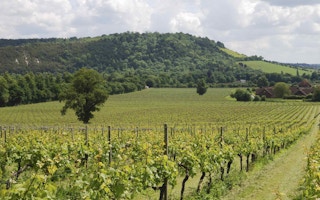Average growing season temperatures in southern England in 10 of the years since 1989 have matched those normal in the wine-growing Champagne region of France five decades ago.
The vineyards in southern England dedicated to sparkling wine are now larger than those of Tasmania, and some wines produced in Kent and Sussex in 2015 outperformed competitors from Champagne. One French Champagne giant has announced the purchase of a vineyard in England.
The grape has become another index of climate change. Just as US scientists pronounced that climate conditions for the famous French wine regions have begun to shift, so UK and Canadian researchers have tentatively suggested that climate change has begun to improve quality and yield in English vineyards.
“Since 1993, the average southern England growing season temperature has been consistently above 13°C, and since 1989 there have been 10 years where the temperature was 14°C or higher (up to 2013),” Nesbitt says. “This is around the same temperature as the sparkling wine producing region in Champagne during the 1960s, 70s and 80s.
“However, by comparison, UK wine yields are very low. In Champagne, yields can be more than 10,000 litres per hectare, but in the UK it is around 2,100 litres on average.”
Warmest years
The UK has warmed faster than the global average, and the seven warmest years in the last hundred or so have all occurred since 2002. The area of land devoted to viticulture between 2004 and 2013 has increased by 148%.
And English growers may not have made things easier for themselves in their choice of varieties.
“There has been a drive to produce English sparkling wines such as Chardonnay and Pinot Noir, but these grapes are more sensitive to our climate variability,” Nesbitt says.
By 2100, average temperatures in northern Europe are expected to rise by 2.7°C. So the scientists conclude that in a survey of what they call “opportunities and threats”, further work to establish what grows best, and where, will be necessary.










